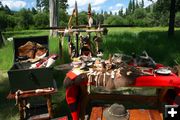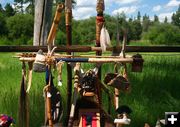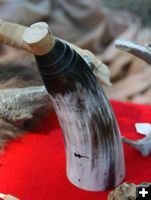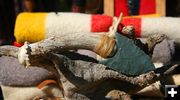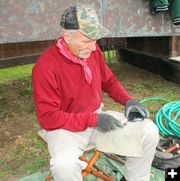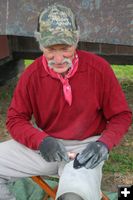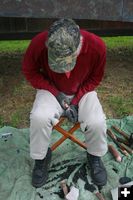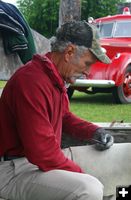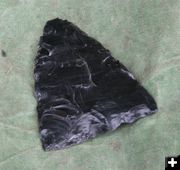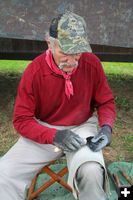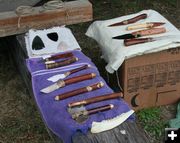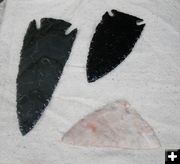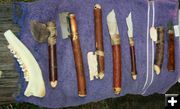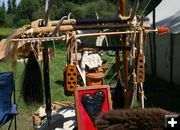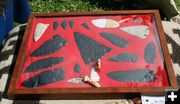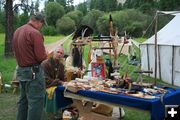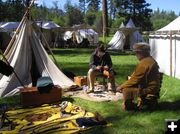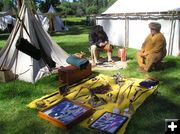
Scroll down for more pictures.
|
|
Bob Gray, Flintknapper
Working with 'the bones of the earth'
by Maggie Craig
Original post July 18, 2012 | Updated July 31, 2012
Have you ever held an arrowhead and wondered about its history? Its origin? Bob Gray has an interesting hobby, one that some of you may have seen at the Two Rivers Rendezvous, or most recently at the Heritage Museum grand opening in early June. His hobby is flintknapping, the art of creating sharpened stone tools such as knives, arrowheads, scrapers and ax heads.
Webster’s dictionary defines the word "knap" (verb), as: to break with a quick blow; especially: to shape (as flints) by breaking off pieces. The term flint, when used with regard to flintknapping, generally refers to any flint-like rock material, such as obsidian or jasper, which fractures in a specific way (called conchoidal fracturing, or breaking into sharp-edged pieces) when struck.
The world’s earliest inhabitants became masters of the art, creating stone tools to use for hunting, digging and warfare. In fact, knapping stone is probably one of the two most important advances that early humans made in the history of man’s evolution, with the other being the deliberate use of fire.
Bob grew up in Texas, and lived in an area with an abundance of flint. He was intrigued with the history of Native Americans, and how their survival depended on sharpened stone tools. He was surrounded by arrowheads and blades rich with the history of our country’s first occupants, and he was fascinated. Here were the tools that Native Americans used for thousands of years, that ensured their survival, that were used to feed, clothe and house them, and Bob’s interest grew. He was not only interested in the stone blades that surrounded him as a child, but in all the skills that were used to live off the land independently.
Bob eventually landed in northwest Montana and settled in a cabin in Silver Butte with no electricity and no running water. He needed to improve his skills in order to live as independently as he possibly could; skills such as rope-making, tanning, making bows and arrows, and flintknapping.
In 2001, Bob attended a rendezvous (historically, a gathering of fur trade era mountain men, explorers and Native Americans to barter, trade and sell provisions) in Polebridge, where he met a fellow who became Bob’s teacher and mentor in flintknapping. Bob had to learn in a very difficult fashion…his tutor lived in Rathdrum, Idaho, and most of Bob’s initial learning was done by phone. However, Bob credits some spiritual guidance along the way with helping him learn his craft. Although he visited his teacher a few times to get hands-on instruction, most of Bob’s learning came from thousands of hours of trial-and-error and a spiritual kinship with those who came thousands of years before him.
In the intervening ten years or so, Bob has honed his ability so that he can make his blades as thin and sharp as steel. He buys his stone from friends or occasionally finds raw materials himself. Several types of quartz are used: flint, chert, jasper, chalcedony, and agate; and volcanic stone: dacite and obsidian. For an interesting article about flint, including the common nomenclature assigned to various types of rocks, visit this Geology.com web page: Geology.com/Flint. Two hundred pounds of jasper converts into about two weeks' worth of flintknapping.
Bob uses a stick with a copper head attached for his percussion flaking (the initial striking of the stone to get it down to a rough size and shape of the blade), although some might use rocks or antlers. As he’s working, he uses a rock for grinding the edges of his stone piece; if not ground around the edges during the process, the stone will shatter. As he nears the desired shape and thickness of the stone (the pre-form stage), he begins pressure flaking, which requires the use of a pointed tool placed on the edge of the stone and applying pressure. Pressure flaking removes small, thin flakes, which shapes and refines the point. This is really where the art of flintknapping becomes apparent: the patient refinement of the blade until it attains its perfect size, thickness and shape. The eventual shape will be thicker in cross-section through the middle, and thin on the point and base, with edges as sharp as steel.
Not only does the art of flintknapping require that stone be pounded and shaped into thin blades, but those blades need to be attached to handles of some sort. That in itself is an art. There are different ways to attach handles, which require different sorts of notches on the blade: on a side, end, or a corner. The shape of the blade can determine where a notch goes, or the rock’s imperfections can determine where the notch might be better placed. Handles can be made of wood or antlers and are attached most commonly with sinew. Bob uses no power tools when making the handles for his blades, which furthers the authenticity of his work.
Literally thousands of hours have been invested into any individual piece that Bob has made. Not that a piece takes that long to make, but that’s the time spent on the craft that he has painstakingly practiced over the last decade.
Bob’s mission: to make beautiful, functional stonework. His goal: to perfect his work. Although accomplished, he strives to do better yet, and willingly spends the time and effort on the pastime he loves. Beyond being a hobby, Bob sells his work at regional rendezvous and festivals, mostly to collectors who appreciate the artistry and time involved in making projectile points.
Bob is hoping to attend the Two Rivers Rendezvous coming up July 20-22 at Fawn Creek Campground. If you would like to see Bob in action, perhaps he’ll be there to explain and demonstrate the process of flintknapping. The results are beautiful. Simple shapes made from the "bones of the earth," with a kindred connection to eons of history.
July 31, 2012 Update: Bob did attend the 2012 Two Rivers Rendezvous, and a few of his works are shown at right. Bob can be reached at (406)293-4517 in Libby.
__________________________________________________
Photos by Maggie Craig, LibbyMT.com
|

